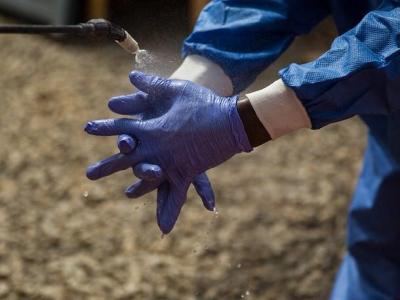CDC eases travel restrictions for pregnant women looking to avoid Zika
The US Centers for Disease Control and Prevention (CDC) last month quietly downgraded its travel restriction guidelines for pregnant women, the Washington Post reported yesterday.
The dialing back occurred as Zika transmission has dropped in 88 countries—many in South America. According to the CDC, the only country pregnant women should avoid traveling to because of Zika is India. A CDC spokesperson told the Post that the World Health Organization (WHO) will soon follow suit.
The CDC advises that pregnant women or those attempting pregnancy talk to their doctors before traveling to countries that had high levels of Zika activity in 2015 and 2016. But the agency also said the risk of contracting Zika in these countries is ultimately unknown.
"If you decide to travel [to a country with a previous documented Zika outbreak], prevent mosquito bites and sexual exposure to Zika during and after travel. If traveling without male partner, wait 2 months after return before becoming pregnant," the CDC said on its travel page.
Zika is the only known mosquito-born virus to cause birth defects in fetuses and infants, which can include microcephaly, or a smaller-than-normal head and brain, with associated brain abnormalities.
Mar 20 Washington Post story
CDC Zika travel page
Experts call for more investment, accelerated R&D to end TB epidemic
A new report from an international group of tuberculosis (TB) and global health experts argues that increased funding for proven strategies, accelerated research and development of new diagnostics and therapies, and shared responsibility will be required to end the TB epidemic within a generation.
The report from the Lancet Commission on tuberculosis, published yesterday in The Lancet, focuses on five investment priorities that are required to achieve the mandate of the 2018 United Nations High-Level Meeting on TB, which called for countries to ramp up efforts to achieve an 80% reduction in TB incidence and a 90% reduction in mortality by 2030. Those are the key milestones of the WHO's End TB Strategy.
To reach those goals, the commission calls for investments in high-quality diagnostics and treatment, including drug-susceptibility testing, for all TB patients seeking care; increased budgets for programs that reach people and populations at high risk for TB and bring them into care; greater investment in new diagnostics, therapies, and vaccines; more financing for proven TB prevention and control efforts in low- and middle-income countries; and more accountability mechanisms to ensure that countries that are doing all they can to end the epidemic.
The commission estimates that global investment in TB research and development will need to increase significantly—from $772 million in 2017 to at least $2 billion per year over the next 4 years—to achieve the goals of the End TB strategy.
"The prospect of a tuberculosis-free world is not just a distant aspiration. It is a realistic objective that can be achieved with the right commitment of leadership and resources," the authors of the report write. "With targeted, proven strategies, smart investments based on sound science, accelerated research and development, and a shared responsibility, we can defeat tuberculosis within a generation."
Mar 20 Lancet Commission report
Foodborne disease sickens 45,000 nondeployed Army troops a year: study
A study today in Epidemiology & Infection estimates that foodborne disease related to five leading pathogens causes more than 45,000 illnesses annually in nondeployed active-duty US Army troops.
The researchers used data from a 2015 US Army population survey, a 2015 US Army laboratory survey, and the FoodNet national disease database to create two models to estimate disease burden. One used scaled-up case counts of Campylobacter jejuni, Shigella spp., Salmonella enterica and non-O157 Escherichia coli from 2010 to 2015. The second estimated the annual burden of norovirus illness based on cases of acute gastrointestinal disease.
Combined, the two models led to estimates of 45,600 annual illnesses (range, 30,300 to 64,000) from the five pathogens. Norovirus, C jejuni, and S enterica caused the most illness.
The authors conclude, "The US Army has a robust food protection program in place, but without a specific active FBI surveillance system across the Department of Defense, we will never have the ability to measure the effectiveness of modern, targeted interventions aimed at the reduction of specific foodborne pathogens."
Mar 21 Epidemiol Infect abstract
Sudan to begin country's largest yellow fever vaccination campaign
The WHO announced yesterday that Sudan will vaccinate more than 8 million people by Mar 29 in the country's largest-ever yellow fever vaccination campaign.
The campaign targets Sudanese ages 9 months to 60 years in Blue Nile, Gezira and Sennar states.
"The campaign represents a crucial step in protecting a large portion of the population and reducing the risk of severe and deadly yellow fever outbreaks in the country," the WHO said. "It is the third and final drive that Sudan is undertaking to protect populations at risk and prevent yellow fever epidemics, pending the implementation of infant immunization as routine practice." Sudan has teamed up with the WHO, Gavi, the Vaccine Alliance, and UNICEF to complete the campaign.
According to the WHO, Sudan is primed for a yellow fever outbreak because of a combination of climate and ecological factors coupled with low population immunity.
Mar 20 WHO statement
Study: Groundwater vulnerable to Cryptosporidium contamination
A 2-year sampling of wells in Minnesota found evidence of Cryptosporidium parasite, which can cause gastrointestinal symptoms and fever, in 40% of public water systems, even in some sourced by groundwater that wasn't affected by potential contamination from surface water. Researchers described their findings today in Environmental Science and Technology.
Most Cryptosporidium outbreaks related to drinking water have been linked to surface water such as lakes and rivers contaminated by sewage discharge or livestock runoff. Ground water aquifers have been thought to be less vulnerable, because of the ability of soil and sediments to filter Cryptosporidium oocysts. Groundwater is typically exempt from US Environmental Protection Agency rules requiring public water systems to monitor and treat for the parasite, unless the source is known to be affected by surface water.
For the study, the researchers collected water samples over a 2-year period from 145 wells that supply public water systems in Minnesota. They used a sensitive test called quantitative polymerase chain reaction to assess for Cryptosporidium DNA. Of wells tested, 40% were positive at least once, and 15% were positive more than once. Standard microbiologic testing also revealed the parasite in some of the wells.
Contamination prevalence and levels were similar, regardless of whether groundwater was influenced by surface water, hinting that soil may not completely prevent oocysts from reaching groundwater. The authors also said their findings suggest that more study is needed to identify how Cryptosporidium got into groundwater wells.
Mar 21 Environ Sci Technol abstract
Mar 21 American Chemical Society press release











